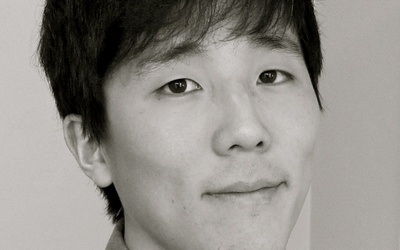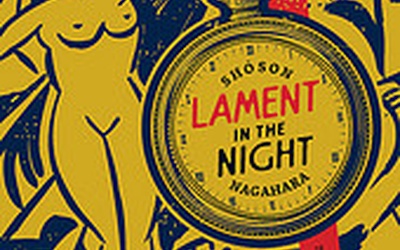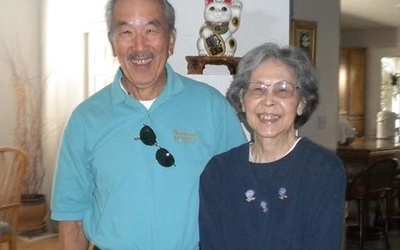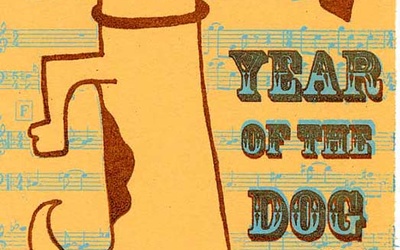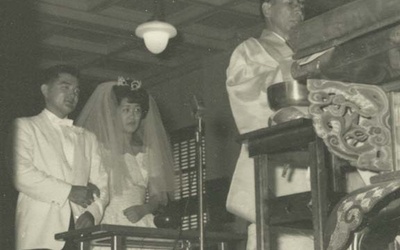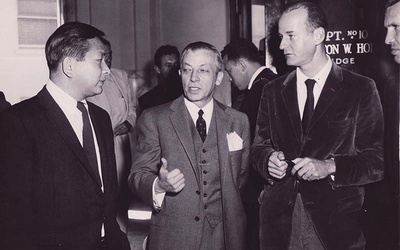
Patricia Wakida
@wasabipressPatricia Wakida es editora de dos publicaciones sobre la experiencia japonés-estadounidense, Only What We Could Carry: The Japanese-American Internment Experience y Unfinished Message: the Collected Works of Toshio Mori . Durante los últimos quince años, ha trabajado como historiadora literaria y comunitaria, incluida curadora asociada de historia en el Museo Nacional Japonés Americano, editora colaboradora del sitio web Discover Nikkei y editora asociada del proyecto Densho Encyclopedia . Forma parte de varias juntas directivas sin fines de lucro, incluidas Poets & Writers California, Kaya Press y la California Studies Association. Patricia ha trabajado como aprendiz de fabricante de papel en Gifu, Japón y como aprendiz de impresor tipográfico y encuadernador manual en California; mantiene su propio negocio de bloques de linóleo y tipografía bajo el sello Wasabi Press. Ella es una Yonsei, cuyos padres fueron encarcelados cuando eran niños en los campos de concentración estadounidenses de Jerome (Arkansas) y Gila River (Arizona). Vive en Oakland, California con su esposo Sam y Gosei, el hijo de Hapa (japonés mexicano), Takumi.
Actualizado en agosto de 2017
Historias de Este Autor
An Interview with Lament in the Night translator Andrew Leong
21 de febrero de 2013 • Patricia Wakida
Last week, Patricia Wakida wrote a profile on translator Andrew Leong on his upcoming book, Lament in the Night, a collection of two novellas by previously forgotten Issei writer, Nagahara Shoson. She also had an opportunity to join Kaya Press staff to interview Andrew about the project. Here is an excerpt from that conversation. Kaya Press (KP): Why did you decide to start this project? Andrew Leong (AL): It started out as a language-learning exercise. Very early on, when I …
Lament in the Night, translated by Andrew Leong
15 de febrero de 2013 • Patricia Wakida
The Tale of Osato is an astonishing fable of pre-war Los Angeles, whose protagonist is a determined young Issei who works herself to the point of collapse every night in a Little Tokyo restaurant to support herself and her infant son. In a particularly harrowing passage, Osato places her son in an orphanage located in the nearby neighborhood of Boyle Heights; a last resort for a desperate single mother who realizes that it is impossible for her to care for …
And the Soul Shall Dance
14 de agosto de 2012 • Patricia Wakida
About a year ago, my mother called to tell me that my grandmother had stopped eating. It was expected that she would deteriorate rapidly in the coming weeks, maybe days. Come home, she said, it was time to say goodbye. Within a day, I found Bachan at my aunt’s house in Fresno. As I held her fragile hands between my own, I was especially sensitive to feeling her bones swimming beneath the skin, its surface freckled with age and blue …
Akira Horiuchi: A Reluctant Hero's Journey to the Congressional Gold Medal Ceremony - Part 2
30 de abril de 2012 • Patricia Wakida
Read Part 1 >>Akira Horiuchi was born and raised in Southern California. In the pre-war years, his father ran a small fruit stand on the Westside of town, and then picked up work as a truck driver hauling vegetables from farmers to the produce market on 9th street. On December 7, 1941, Horiuchi’s father went to visit friends who lived and worked on Terminal Island, San Pedro. Unfortunately, immediately following the bombing of Pearl Harbor, certain businesses and districts along …
Akira Horiuchi: A Reluctant Hero's Journey to the Congressional Gold Medal Ceremony - Part 1
23 de abril de 2012 • Patricia Wakida
To be drafted by the Government, to serve your country in time of war under such conditions that existed at that time, incarceration of all persons from the west coast with the wrong color face by abrogating all constitutional rights, racist discrimination wherever you went…left me quite apprehensive about my future.—Aki Horiuchi, testimony to the 1981 Los Angeles Commission on Wartime Relocation and Internment of Civilians Of the three hundred and thirty-three Japanese American veterans of World War II that …
Animal Menagerie
6 de enero de 2012 • Patricia Wakida
Susan S. has an annual tradition that she’s followed for over thirty-six years, animal by animal. Having been lucky enough to have spent the past twenty years as an archivist at a world-class library where she gets to roam its stacks, attics, and moats at will, she is a great lover of ephemera and the collectable memorabilia of our past. An accomplished author of many beautiful books, Susan also practices an art known to few in this country, a habit …
Fate and the Downtown Fresno Betsuin Temple
13 de diciembre de 2011 • Patricia Wakida
When I was nine years old, the Sunday ritual was to drive the five miles or so from our home in Tarpey Village in Clovis until we were out where long dirt driveways led to vineyards and farmer homes, where a single oak tree shaded a tiny, unmarked bungalow. Steel grey folding chairs were brought from the closets and the children were instructed to plunk zabuton on each chilly metal seat, candles and thin green rods of incense were lit, …
In Search of Shigeyoshi Murao
3 de noviembre de 2011 • Patricia Wakida
“Imagine being arrested for selling poetry!” So were the astonished words of Shigeyoshi Murao, the legendary manager for over two decades of City Lights Bookstore, literary haven for bookworms worldwide. But in the summer of 1957, the Japanese American book clerk, affectionately known as “Shig” by everyone in the neighborhood, was in fact arrested on charges of obscenity after selling undercover San Francisco police officers a copy of Allen Ginsberg’s Howl and other Poems. Murao is virtually unknown to today’s …
Yoshiko Wada
30 de noviembre de 2010 • Patricia Wakida
“When my two sisters and I were younger, we lived in my maternal grandparents’ home in Tokyo....In those summer months, we could hardly wait to finish supper so that we could put on our yukata and run outdoors to participate in the folk dance practice sessions for the Obon Odori festival....All three sisters wore fabric with the same design motif because our three yukata were made out of two bolts of cloth. We needed Grandmother Tsuru’s help to put on …

